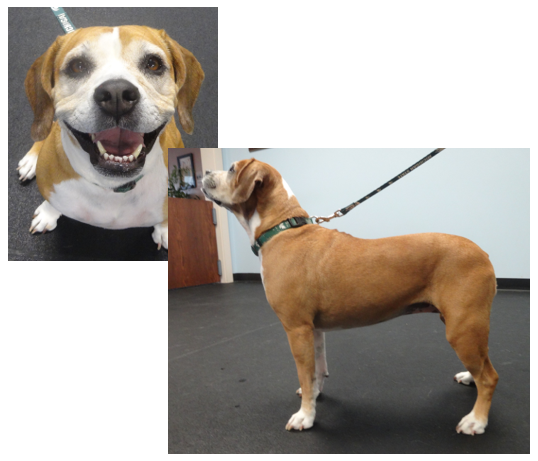The Genetic Quilt, A Look at Heritage in Dogs
by Cathryn Adolph, LVT, CCRP
Did you know? I didn’t…

Peanut, is a Bulldog Beagle Mix. In her posture, you can see physical characteristics from both breeds.
A few days ago, I discovered that the end of the month is National Mutt Day. It is a day to draw attention to all of the wonderful mixed breed dogs. It is even celebrated twice a year on July 31st and December 2nd. Genetics amaze me, and nowhere more than sibling mixed breed dogs. It got me thinking about all the wonderful mixed breed dogs we see at Pawsitive Steps Rehabilitation. Heritage can affect not only looks and personality but structure, gait, muscle physiology, and exercising.
Cut from the same cloth
In rehabilitation, posture and gait are continually being evaluated. What is normal for one breed, may be abnormal for another. A Labrador Retriever with elbows held outward is abnormal for the breed, while it is considered normal in bulldogs, such as the English Bulldog. Border Collies often stalk their flock and walk with their head held very low. While this is normal for them, it can be a sign of lameness in other breeds.
Muscle composition (type I and II fibers) can also be influenced by genetics. Greyhounds are known for their ability to sprint at high speeds, but they have limited endurance. Whereas, Huskies are known for their ability to run long distances in adverse weather conditions.
Breed related orthopedic conditions are common, as we discussed in our May blog. There are also neurologic disease processes that we also treat in rehabilitation, such as degenerative myelopathy (DM).
Cut from a different cloth
While knowing parentage (even of our mixed breeds) is nice, we have many patients that offer no clues as to their possible heritage. We use visible clues to determine if posture and gait are normal for the individual.
While mix breed dogs are generally considered healthier, it is no guarantee that a mix breed dog will not have a breed related orthopedic condition. I have met a few that unfortunately inherited bad genetics from both parents, including my own dogs.
The pattern
Form and structure effect function and movement, this can be both good and bad. When looking at the shoulders in terriers, including some terrier mixes, they are very “straight.” This terminology means the shoulder blade is positioned more vertically compared to other dogs.
While this may seem insignificant, in rehabilitation we are trying to return to a gait that is normal for the individual. Straight shoulders cannot reach as far forward. Without knowing this, we could spend a lot of time trying to fit a square peg into a round hole.
The most beautiful quilt
No matter your dog’s heritage, each pet is an individual. Heritage can help explain posture, gait, and structure but, it is not necessary to know. All of us are an amazing blend of the genes we inherited; we are all mutts!
